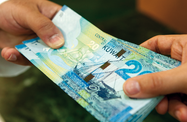The continued conservative approach of Kuwaiti banks, both Islamic and conventional, seems to be paying off, with a number of institutions posting strong returns for the third quarter and several banks reporting double-digit quarterly increases in net profits for the period.
Net profit at the National Bank of Kuwait, the country’s largest by total assets, rose to KD228.92m ($812.52m) – a 1.49% increase from KD225.56m ($800.59m) in the third quarter of 2011. While year-on-year (y-o-y) growth looks small compared to some of the country’s other financial institutions, it should be noted that the bank recovered from negative growth in the second quarter, when net profit stood at KD120.81m ($428.8m) – a y-o-y decrease of 17.63%. Growth in the previous quarters, while positive (0.24% and 0.3% for the first and second quarters, respectively), was lower than the third-quarter figures.
Smaller institutions, meanwhile, have posted larger growth margins. The second-largest financial institution and the biggest among Islamic lenders, Kuwait Finance House (KFH), reported a 7.2% y-o-y increase at the end of October, with shareholders’ net profit increasing to KD75.9m ($269.39m) for the first nine months of the year. This was up KD33.74m ($119.76m), or 80%, over the second quarter and up KD5.1m ($18m), or 7.16%, y-o-y as profits recovered from the higher levels of provisions made in late 2011 and early 2012. The reported figures were well above the expected quarterly growth rate, with four analysts in a Reuters survey predicting a growth of KD19.7m ($69.92m) for the quarter.
According to a report by state news agency KUNA, the bank’s total revenues stood at KD611.9m ($269.39m) for the first nine months of the year, a 6% increase over the same period in 2011. Additional growth occurred in the bank’s total assets, which rose to KD14.2bn ($50.4bn), up 6.3% y-o-y, while deposits rose 2% to KD8.9bn ($31.59bn).
In a statement released on October 24, Mohammad Al Khudairi, the new chairman of KFH, said growth could be attributed to the bank’s conservative approach, with the possibility of further expansion if the government pursues spending that is “based on a clear plan with defined objectives”. He added that the bank has increased its efforts to connect finance in the Gulf with markets further afield, such as in Turkey and Malaysia.
Burgan Bank, a subsidiary of the Kuwait Projects Company (KIPCO) and the fourth-largest bank by total assets, reported a net profit of KD46.38m ($164.62m) for the quarter – up 12% from KD41.39m ($146.91m) in the third quarter of 2011. Burgan Bank’s strong performance could be partly due to increased investments in KIPCO, spurred by a number of infrastructure projects the organisation is carrying out.
While the other two institutions in the top five, Gulf Bank and the Commercial Bank of Kuwait, have posted y-o-y losses throughout 2012, their net profits have been slowly recovering over the course of the year. Gulf Bank, the third-largest by market value, posted a net profit of KD22.4m ($79.51m), down 18.25% from KD27.4m ($97.25m) in the third quarter of 2011, but up 75% from KD12.79m ($45.39m) in the second quarter.
Other indicators for the bank are quite positive, with operating profits up 11% y-o-y and total assets up 3.53%. Mahmoud Al Nouri, the chairman of Gulf Bank, said in a statement on October 31 that the y-o-y losses in 2012 were due to transfers to the bank’s precautionary general provisions.
The Commercial Bank of Kuwait (CBK), meanwhile, has not yet released its third-quarter results. The CBK’s net profit for the second quarter increased from KD330,000 ($1.17m) in the first quarter to KD450,000 ($1.59m) – a 36% quarterly gain, though down nearly 70% y-o-y.
A statement released by the CBK attributed losses to the transfer of funds to provisions. “The bank continues a prudent policy towards building up a strong provision base and consolidating its balance sheet,” said Fowzi Al Ateeqi, the general manager of investments and secretary to the board at the CBK. Total assets for the second quarter remained consistent at KD3.7bn ($13.13bn) – unchanged from the figure in the second quarter of 2011.
Ratings agency Moody’s has said Kuwait is not likely to enter a credit-negative situation due to “the government’s very strong credit fundamentals”. Indeed, given their current conservative approach to lending and demonstrated ability to maintain strong fundamentals, as well as the ability to build up provisions even in difficult times, it seems many of the country’s financial institutions are on course to maintain growth in the months to come.

